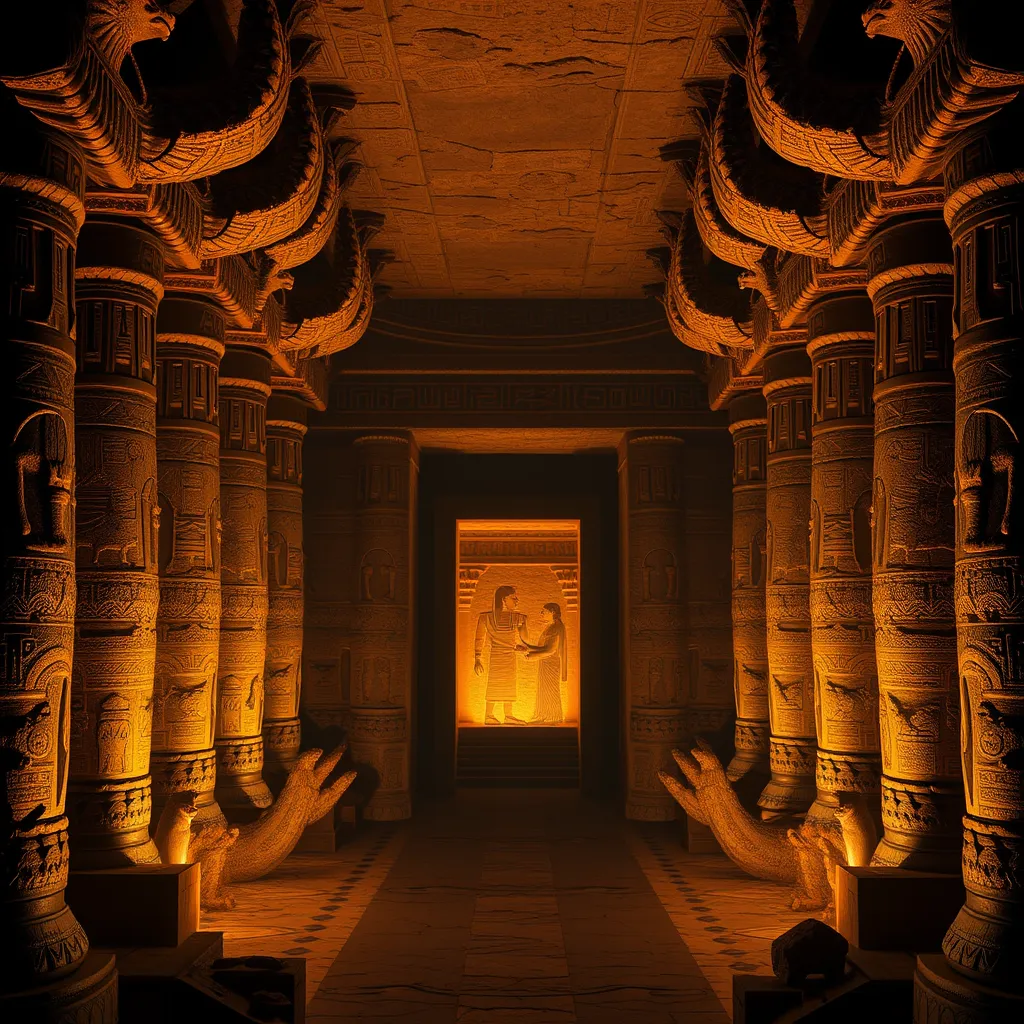The Duat: Exploring the Myths and Legends of the Egyptian Underworld
I. Introduction to the Duat
The Duat, often referred to as the Egyptian Underworld, is a complex and richly mythological realm in ancient Egyptian belief systems. It serves as the setting for the journey of the deceased after death, a pivotal aspect of their cosmology. The significance of the Duat lies not only in its function as a place of judgment and resurrection but also as a reflection of the ancient Egyptians’ understanding of life, death, and the afterlife.
In ancient Egyptian mythology, the journey after death is a transformative experience for the soul. Upon passing, individuals embark on a perilous voyage through the Duat, facing various trials and challenges before achieving eternal life in the Field of Reeds, a paradise resembling the life they knew on Earth.
II. The Structure of the Duat
The Duat is often depicted as a vast and multi-layered realm, comprising various landscapes and realms that the deceased must navigate. This underworld is not a singular place but rather a series of interconnected areas, each with its own characteristics and challenges.
- Geographical Features: The Duat is marked by key geographical features such as rivers, mountains, and valleys. The River of Night, often associated with the Milky Way, serves as a vital waterway that the soul must cross.
- Regions of the Duat: Various regions within the Duat are described in ancient texts, including:
- Fields of Iaru: A lush paradise where the blessed reside.
- Amduat: A realm where the sun god Ra travels during the night, facing various obstacles.
- Duamutef: The area associated with mummification and rebirth.
III. Deities and Entities of the Duat
The Duat is home to numerous deities and entities that play critical roles in the journey of the deceased. These figures embody various aspects of mortality and the afterlife.
- Osiris: The god of the afterlife, Osiris governs the Duat and presides over the judgment of souls. He represents resurrection and eternal life.
- Anubis: The jackal-headed god associated with mummification and the protection of graves, Anubis guides souls through the Duat and oversees the weighing of the heart.
- Other Entities: Various spirits, including guardians and monsters, challenge or assist the deceased. Creatures like the Ammit, a hybrid of lion, hippopotamus, and crocodile, are feared for their role in devouring unworthy souls.
IV. The Journey Through the Duat
The journey through the Duat is fraught with trials and tribulations, symbolizing the soul’s quest for immortality and acceptance by the gods. This journey is marked by several key steps and challenges:
- Crossing the River: The deceased must navigate the treacherous waters, often guarded by monstrous beings that represent their fears and sins.
- Facing Challenges: Throughout the Duat, the soul encounters various trials that test their worthiness.
- Weighing of the Heart: This essential ceremony involves the deceased’s heart being weighed against the feather of Ma’at, the goddess of truth and justice. A heart lighter than the feather signifies a life of virtue.
If the heart is heavier, the soul faces annihilation at the jaws of Ammit, signifying a complete loss of identity and existence.
V. Symbolism and Themes in Duat Myths
The myths surrounding the Duat are rich in symbolism and themes that reflect the ancient Egyptians’ beliefs about life, death, and the afterlife.
- Judgment: The theme of judgment is central to the Duat, highlighting the moral and ethical standards by which lives are assessed.
- Resurrection: The journey through the Duat represents a cycle of death and rebirth, with Osiris serving as a powerful symbol of resurrection.
- Immortality: The ultimate goal of navigating the Duat successfully is achieving immortality and eternal life in the Fields of Iaru.
Various elements within the Duat, such as the presence of deities and the trials faced, symbolize deeper meanings about the nature of existence, morality, and the afterlife.
VI. Art and Literature Depicting the Duat
Ancient texts and artistic representations provide valuable insights into the Duat and its significance in Egyptian culture. The Book of the Dead is one of the most significant texts, serving as a guide for the deceased in navigating the afterlife.
- The Book of the Dead: This collection of spells and prayers was designed to assist the deceased in overcoming challenges in the Duat and achieving a favorable judgment.
- Artistic Representations: Tomb paintings, carvings, and papyrus illustrations depict scenes from the Duat, including the weighing of the heart and encounters with various deities. These artworks were essential in ensuring that the deceased could navigate the afterlife successfully.
VII. The Duat in Modern Culture
The myths and legends of the Duat continue to influence contemporary culture, permeating literature, film, and art. Modern interpretations often draw upon the rich symbolism and themes present in ancient Egyptian mythology:
- Literature: Many authors have incorporated elements of the Duat into their works, exploring themes of death, judgment, and the afterlife.
- Film: Movies often portray the Duat as a mystical and dangerous realm, emphasizing the dramatic aspects of the soul’s journey.
- Art: Contemporary artists frequently reference Duat imagery, exploring its themes in relation to modern spirituality and existential questions.
There has been a resurgence of interest in ancient Egyptian mythology, with many seeking to understand the rich tapestry of beliefs and practices that characterized this ancient civilization.
VIII. Conclusion
The Duat remains a powerful symbol of the ancient Egyptians’ understanding of life, death, and immortality. Its complex narrative and rich mythology continue to captivate scholars and enthusiasts alike, offering deep insights into the human condition and our quest for meaning beyond death.
As modern spirituality evolves, the relevance of the Duat’s myths resonates with contemporary audiences, inviting reflection on our own beliefs about the afterlife and what it means to live a virtuous life. The enduring legacy of the Duat illustrates not only the depth of ancient Egyptian spirituality but also its continued impact on modern culture.




